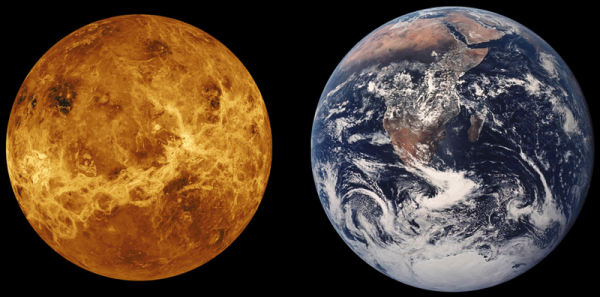
We call it the morning star or the evening star or Earth’s twin. Twice a century the planet’s orbit passes directly between Earth and the Sun. This Transit of Venus occurred on June 5, 2012. In Seattle it rained. But even if you had to make do with the NASA feed, to witness that dark golf ball of a planet inch its way (at 22 miles per second) across the immense sun was to be wowed.
Transits of Venus enabled astronomers of old to figure out the length of one AU, one Astronomical Unit, the distance from Earth to Sun. This is because the same object viewed from different vantage points appears to be in different locations. By precisely timing the beginning and end of the transit from various Earth locations, you could draw triangles from the lines of sight. Since you knew the length of the earthbound baseline and the angles of the sightlines, it became a trigonometry problem to figure the length of the other sides, i.e., the distance from here to there.
Earth and Venus are similar in size and mass. Venusian brightness is due to the planet’s high albedo (al-BEE-doe—reflectivity). The albedo of Venus is 75 percent—75 percent of the sunlight hitting it reflects back. (For comparison, the Moon’s albedo is 12 percent.) The Venusian atmosphere is largely carbon dioxide, a greenhouse gas, which causes Venus to heat up hotter than the proverbial hell, nearly 900 degrees F. (The atmosphere is also 90 times heavier than our own.) High in the atmosphere, thick sulfuric acid clouds reflect sunlight back into space.
It’s likely that Venus once had an ocean. If so, it evaporated in a catastrophic runaway greenhouse effect, a dread event of intense interest to us earthlings. Earth and Venus have about the same amount of carbon dioxide, but most of ours is locked up in carbonate rocks such as limestone. On both planets, volcanoes made the original atmosphere by outgassing water vapor, sulfuric acid, and carbon dioxide. At a certain point in planetary formation the temperature dropped enough to turn water vapor into rain. It rained and it poured and the oceans filled. Oceans dissolve carbon dioxide, enabling much of the CO2 to marry the sediments that make the rocks.
But oceans can boil away. (Venus is closer to the Sun, which over time grew hotter.) The temperature rises. Liquid water turns into water vapor, also a greenhouse gas. Water vapor holds in heat, causing the temperature to rise further, causing even more ocean to evaporate. It becomes too hot to rain. The ocean disappears. There’s no water to dissolve CO2, and it mounts up in the air. The sun breaks up vaporized H2O, and the hydrogen and oxygen escape into space, leaving carbon dioxide. Leaving a place hot, dry, and horrible. Leaving Venus.
In our solar system, planets orbit counterclockwise, all close to the same plane, called the elliptic. (Imagine planets forming out of the debris in a hot spinning disc with the Sun forming at its center and you will see why the planets orbit within a narrow disc-like plane.) Most planets also turn on their axis in the direction of orbit, toward the east. Our Sun “rises” in the east because Earth turns toward the east. But Venus turns toward the west. On Venus the Sun rises in the west and sets in the east. Why? Possibly, during the formation of the solar system—think spinning disc—a planetesimal smashed into baby Venus from its east side, merging with it and dragging its rotation into reverse.
The planet rotates so slowly that one Venus day is 117 Earth days long. Meanwhile, the time Venus takes to orbit the Sun is 225 Earth days long. So it has a long day and a short year (to our way of thinking). And, although Venus rotates against the direction of its orbital travel, its high sulfuric-acid clouds whip around the planet at hurricane speed the other way—in the direction of the orbit.
Venus our twin is not so identical. The planet resurfaced itself some 400 to 700 million years ago. What happened? It lacks plate tectonics, which likely requires water to soften rock. In the 1970s and 1980s, Soviet landers photographed (for an hour, before being cooked and crushed) a bleak, cracked, parched landscape. Subsequent American and European missions flying by or orbiting confirm that Venus should be avoided as a vacation destination.
Venus was the Roman goddess of love, whom the Greeks called Aphrodite. She was forbidding, fierce, wild, and hot. Our Venus, shining so bright and pretty up there, is exactly that.

